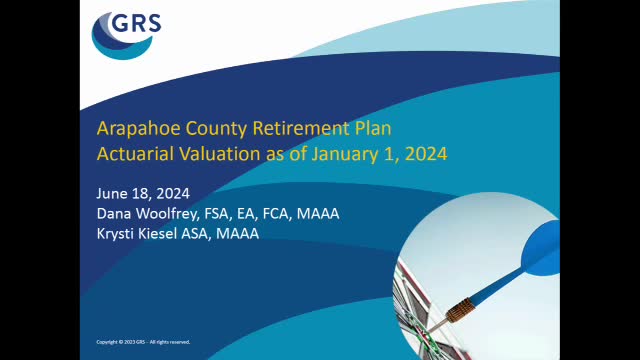Retirement plan shows signs of recovery after years of decline
June 18, 2024 | Arapahoe County, Colorado

This article was created by AI summarizing key points discussed. AI makes mistakes, so for full details and context, please refer to the video of the full meeting. Please report any errors so we can fix them. Report an error »

During a recent government meeting, officials provided an annual update on the condition of the retirement plan, highlighting both challenges and signs of improvement. The presentation, based on an actuarial evaluation from January, revealed a modestly optimistic outlook due to population growth and favorable experiences over the past year. However, legacy issues from previous decades continue to pose significant challenges.
The retirement plan, which has faced substantial unfunded liabilities stemming from overly generous benefit promises made in the 1980s and 1990s, remains under pressure. The funded ratio, a key metric comparing assets to obligations, has stagnated in the low sixties, with the plan reported at 60% funded as of January 2023. This translates to a shortfall of approximately $243 million, a figure that has seen only slight improvement despite ongoing efforts to stabilize the plan.
To address these legacy issues, the retirement board has implemented tiered benefits for new hires and temporarily reduced benefits for current members during a legislated window in 2013. These measures have helped to some extent, but the board emphasized that further improvements will require increased contributions from both the county and employees.
In a positive development, the county agreed to raise its contribution rate by 0.25% for 2024, increasing the total contribution to 9.5%. This adjustment is expected to generate an additional half million dollars for the plan, contributing to efforts to pay down the unfunded liability. The plan also reported an 11.5% return on market value assets for 2023, which, while promising, will be smoothed over five years to mitigate market volatility.
Despite the challenges, there are signs of progress. The funded ratio improved slightly to 62%, and the unfunded liability growth has stabilized, indicating that the measures taken are beginning to yield results. The retirement board remains committed to closing the funding gap, projecting that with continued contributions and payroll growth, the plan could reach full funding by 2049.
Officials expressed cautious optimism, noting that while the improvements are incremental, they represent a shift towards a more sustainable future for the retirement plan. The focus will remain on managing contributions and benefits effectively to ensure long-term viability.
The retirement plan, which has faced substantial unfunded liabilities stemming from overly generous benefit promises made in the 1980s and 1990s, remains under pressure. The funded ratio, a key metric comparing assets to obligations, has stagnated in the low sixties, with the plan reported at 60% funded as of January 2023. This translates to a shortfall of approximately $243 million, a figure that has seen only slight improvement despite ongoing efforts to stabilize the plan.
To address these legacy issues, the retirement board has implemented tiered benefits for new hires and temporarily reduced benefits for current members during a legislated window in 2013. These measures have helped to some extent, but the board emphasized that further improvements will require increased contributions from both the county and employees.
In a positive development, the county agreed to raise its contribution rate by 0.25% for 2024, increasing the total contribution to 9.5%. This adjustment is expected to generate an additional half million dollars for the plan, contributing to efforts to pay down the unfunded liability. The plan also reported an 11.5% return on market value assets for 2023, which, while promising, will be smoothed over five years to mitigate market volatility.
Despite the challenges, there are signs of progress. The funded ratio improved slightly to 62%, and the unfunded liability growth has stabilized, indicating that the measures taken are beginning to yield results. The retirement board remains committed to closing the funding gap, projecting that with continued contributions and payroll growth, the plan could reach full funding by 2049.
Officials expressed cautious optimism, noting that while the improvements are incremental, they represent a shift towards a more sustainable future for the retirement plan. The focus will remain on managing contributions and benefits effectively to ensure long-term viability.
View full meeting
This article is based on a recent meeting—watch the full video and explore the complete transcript for deeper insights into the discussion.
View full meeting
